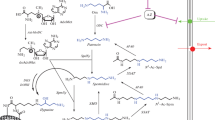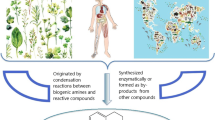Abstract
The principal psychoactive component of marihuana is Δ-9-tetrahy-drocannabinol. This compound at 10−5 molar concentration in the medium of human cell cultures appeared to inhibit DNA, RNA, and protein synthesis by 50, 40, and 30% respectively, as measured by incorporation of radioactive precursors into acid-insoluble cell fractions in human diploid fibroblasts, human neuroblastoma cells, and mouse neuroblastoma cells. While Δ-9-tetrahydrocannabinol inhibited semiconservative DNA synthesis, it had no effect on DNA repair synthesis in human cells as assayed by the photolysis of 5-bromodeoxyuridine incorporation into DNA during repair after ultraviolet radiation damage. Δ-9-tetrahydrocannabinol also had no effect on rejoining of DNA single-strand breaks induced by γ-rays. The nonspecificity of the inhibition of macromolecular synthesis by Δ-9-THC suggested a possible interference with uptake of radioactive precursors. However, experimentation has shown that this depression of macromolecular synthesis cannot be accounted for by reduced transport of radioactive precursors into the cell because the rate of transport of these precursors into the cell is essentially the same in the presence or absence of Δ-9-THC. Pool sizes of macromolecular precursors as measured radioisotopically (3Hthymidine, 3H-uridine, 14C-leucine) appear to be reduced about 50%, and this reduced pool size could fully account for the reduced macromolecular synthesis seen in the presence of Δ-9-THC. We do not know what causes this apparent reduction of pool sizes in the presence of Δ-9-THC.
Zusammenfassung
Die psychoaktive Hauptkomponente des Marihuana ist das Δ-9-Tetrahydrocannabinol (Δ-9-THC). Diese Verbindung scheint in einer Konzentration von 10−5 M im Kulturmedium die DNS-, RNS- und Proteinsynthese um 50, 40 und 30% zu hemmen, wie die Messung des Einbaus radioaktiver Vorstufen in die säureunlösliche Zellfraktion diploider Fibroblasten und Neuroblastomzellen des Menschen sowie Neuroblastomzellen der Maus gezeigt hat. Δ-9-THC hemmt die semikonservative DNS-Synthese, hat aber keinen Einfluß auf DNS-Reparaturprozesse in menschlichen Zellen. Dies wurde durch Photolyse von 5-Bromdesoxyuridine bestimmt, das im Verlaufe der Reparatur in die durch ultraviolette Strahlung geschädigte DNS eingebaut wird. Auch bei Schädigungen durch γ-Strahlen hat Δ-9-THC keinen Einfluß auf die Wiedervereinigung der Einzelstränge. Da keine spezifische Hemmung der Synthese biologischer Makromoleküle durch Δ-9-THC nachgewiesen werden konnte, lag die Vermutung nahe, daß die Aufnahme radioaktiver Vorstufen gestört wird. Jedoch haben die Experimente gezeigt, daß die verringerte Syntheserate nicht einem verlangsamten Transport der radioaktiven Vorstufen in die Zelle zugeschrieben werden kann, denn die Geschwindigkeit des Transportes dieser Vorstufen in die Zelle ist in Gegenwart und Abwesenheit von Δ-9-THC im Wesentlichen die gleiche. Jedoch erscheinen die mit Radioiostopen (3H-Thymidine, 3H-Uridine und 14C-Leucine) bestimmten Pool-Größen auf etwa 50% reduziert, was die durch Δ-9-THC reduzierte Syntheserate für biologische Makromoleküle ausreichend erklären würde. Die Ursachen der durch Δ-9-THC bewirkten Reduktion der Pool-Größe sind uns nicht bekannt.
Similar content being viewed by others
References
Adamson, L. F., Herington, A. C., Bornstein, J.: Evidence for the selection by the membrane transport system of intracellular and extracellular amino acids for protein synthesis. Biochim. biophys. Acta (Amst.) 282, 352–365 (1972)
Agurell, J. R.: Quantitation of Δ 1-tetrahydrocannabinol in plasma from cannabis smokers. J. Pharm. Pharmacol. 25 (7), 554–558 (1973)
Bollum, F. J.: Thermal conversion of non priming deoxyribonucleic acid to primer. J. biol. Chem. 234, 2733 (1959)
Chari-Bitron, A.: Stabilization of rat erythrocyte membrane by Δ 1-tetrahydrocannabinol. Life Sci. 10, 1273 (1971)
Chari-Bitron, A., Bino, T.: Effect of Δ 1 (Δ 8)-tetrahydrocannabinol on ATPase activity of rat liver mitochondria. Biochem. Pharmacol. 20, 473 (1971)
Cohen, G. M, Peterson, D. W., Mannering, G. J.: Interactions of Δ 9-tetrahydrocannabinol with the hepatic microsomal drug metabolizing system. Life Sci. 10, 1207 (1971)
Eagle, H.: Amino acid metabolism in mammalian cell cultures. Science 130, 432–437 (1959)
Gill, E. W., Jones, G.: Brain levels of Δ 1-tetrahydrocannabinol and its metabolites in mice-correlation with behavior and the effect of the metabolic inhibitors SKF 525A and Piperonyl Butoxide. Biochem. Pharmacol. 21, 2237 (1972)
Gross, S. J., Soares, J. R., Wong, S. L. R., Schuster, R. E.: Marihuana metabolites measured by a radioimmune technique. Nature (Lond.) 252, 581–582 (1974)
Harris, L. S., Munson, A. E., Friedman, M. A., Dewey, W. L.: Retardation of tumor growth by Δ-9-tetrahydrocannabinol (Δ-9-THC). Pharmacologist 16, 259 (1974)
Klebe, R. J., Ruddle, F. H.: Clone Neuro-2a. J. Cell Biol. 43, 69A (1969)
Mahoney, J. M., Harris, R. A.: Effect of Δ-9-tetrahydrocannabinol on mitochondrial processes. Biochem. Pharmacol. 21, 1217 (1972)
Mans, R., Novelli, G. D.: Measurement of the incorporation of radioactive amino acids into protein by a filter-paper disk method. Arch. Biochem. Biophys. 94, 48 (1961)
Nahas, G. G., Suciu-Foca, N., Armand, J.-P., Morishim, A.: Inhibition of cellular mediated immunity in marihuana smokers. Science 183, 419 (1974)
Nichols, W. W., Lee, J., Dwight, S.: The IMR-32 cell line. Cancer Res. 30, 2110 (1970)
Paton, W. D. M., Pertwee, R. G., Temple, D. M.: In: Cannabis and its derivatives: Pharmacology and experimental psychology (eds. W. D. M. Paton, J. L. Crowns), pp. 408–427. London-New York: Oxford Univ. Press 1972
Raz, A., Schurr, A., Levine, A.: The interaction of hashish components with human erythrocytes. Biochim. biophys. Acta (Amst.) 274, 269 (1972)
Regan, J. D., Chu, E. H. Y.: A convenient method for assay of DNA synthesis in synchronized human cell cultures. J. Cell Biol. 28, 139 (1966)
Regan, J. D., Chu, E. H. Y., Setlow, J. D., Ley, R. D.: Normal and defective repair of damaged DNA in human cells: A sensitive assay utilizing the photolysis of bromodeoxyuridine. Proc. nat. Acad. Sci. (Wash.) 68, 708–712 (1971a)
Regan, J. D., Chu, E. H. Y., Setlow, R. B. Kaback, M. M., Howell, R. R., Klein, E., Burgess, G.: Zeroderma pigmentosum: A rapid, sensitive method for prenatal diagnosis. Science 174, 147–150 (1971b)
Setlow, R. B., Regan, J. D., German, J., Carrier, W. L.: Evidence that zeroderma pigmentosum cells do not perform the first step in the repair of ultraviolet damage to their DNA. Proc. nat. Acad. Sci. (Wash.) 64, 1035–1041 (1969)
Setlow, R. B., Setlow, J. D.: Effects of radiation on polynucleotides. In: Annual review of biophysics and bioengineering, vol. 1 (ed. M. F. Morales), pp. 293–345. Palo Alto (Calif.): Annual Reviews, Inc. 1972
Tscherne, J. S., Weinstein, I. B., Lanks, K. W., Gersten, N. B., Canton, C. R.: Phenylalanyl transfer ribonucleic acid synthetase activity associated with rat liver ribosomes and microsomes. Biochem. 12, 3859–3865 (1973)
Zimmerman, A. M., McClean, D. N.: In: Drugs and the cell cycle (eds. A. M. Zimmerman, G. M. Padilla, I. L. Cameron), pp. 67–94. New York: Academic Press 1973
Author information
Authors and Affiliations
Additional information
The authors acknowledge, with much appreciation, Lois Chason's expert typing assistance of this manuscript.
Rights and permissions
About this article
Cite this article
Blevins, R.D., Regan, J.D. Δ-9-Tetrahydrocannabinol: Effect on macromolecular synthesis in human and other mammalian cells. Arch Toxicol 35, 127–135 (1976). https://doi.org/10.1007/BF00372766
Received:
Issue Date:
DOI: https://doi.org/10.1007/BF00372766
Key words
- Δ-9-Tetrahydrocannabinol
- Cell cultures
- Human fibroblastic cells
- Human neuroblastoma cells
- Mouse neuroblastoma cells
- Nucleic acids
- Protein
- Precursor pool size
- Membrane transport




